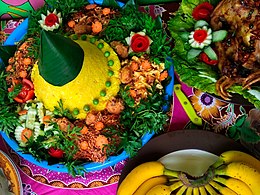Indo cuisine
 |
| This article is part of the series on |
| Indonesian cuisine Masakan Indonesia |
|---|
|
|
Indo cuisine is a fusion cooking and cuisine tradition, mainly existing in Indonesia and the Netherlands, as well as Belgium, South Africa and Suriname. This cuisine characterized of fusion cuisine that consists of original Indonesian cuisine with Eurasian-influences—mainly Dutch, also Portuguese, Spanish, French and British—and vice versa. Nowaday, not only Indo people consume Indo cuisine, but also Indonesians and Dutch people.
History and origin
The Dutch colonial families through their domestic servants and cooks were exposed to Indonesian cuisine, as the result they developed a taste for native tropical spices and dishes. A notable Dutch East Indies colonial dish is rijsttafel, the rice table that consists of 7 to 40 popular dishes from across the colony. More an extravagant banquet than a dish, the Dutch colonials introduced the rice table not only so they could enjoy a wide array of dishes at a single setting but also to impress visitors with the exotic abundance of their colony.[1]
Through colonialism the Dutch introduced European dishes such as
Indo culinary culture has made an enduring impact on Dutch society. There is no other place outside Indonesia with such an abundance of Indonesian food available.
Dishes


- yardlong beans, which are pickled in vinegar, sometimes added with kaffir lime to add citrus aroma, and also dried chillies.
- Babi kecap, pork belly braised in sweet soy sauce.
- Babi panggang, grilled or roasted pork dish served with a tomato-based sauce.
- mung bean paste or red bean paste
- .
- Bamischijf, snack food consisting of a slice of bami, breaded and deep-fried.[6]
- Bistik jawa, Javanese beef steak, a European-influenced dish from Solo. This dish almost similar to selat solo.
- red kidney beansoup, sometimes mixed with pig's trotters, beef or chicken.
- Friet sate, French fries served with satay. This term also refers to French fries topped with peanut sauce.
- Gado-gado, kind of boiled or blanched vegetables salad in peanut sauce.
- Klappertaart, coconut cake made from flour, sugar, milk, butter, as well as coconut flesh and juice.[7]
- Kochi, dumpling made from glutinous rice flour, and stuffed with coconut fillings with palm sugar.
- spring rolls, made of thin paper-like or crepe-like pastry and fillings.
- Lumpia goreng, fried spring roll (lumpia) snack.
- Nasi goreng, fried rice with krupuk or sambal.
- Nasi rames, Indo take on Javanese dishof mixed rice.
- steamed rice, consisting of nasi goreng inside a crust of breadcrumbs.
- Pastel tutup, Shepherd's pie made with chicken and several vegetables such as carrot, green peas and boiled eggs, all topped with mashed potatoes.
- patties, made of ground potatoes, minced meat, peeled and ground corn or tofu, or minced fish.
- Pisang goreng, snack made of banana or plantain, covered in batter or not, being deep fried in hot cooking oil.
- Roti bakar, sandwich toast with various fillings.
- Roti gambang, rectangular shaped brown bread with sesame seeds, flavoured with cinnamon and palm sugar.[8]
- Satay, skewered grilled meat. The popular types of satay in Indo cuisine, includes chicken, pork, goat and croquette satay.
- Satay sauce, peanut sauce.
- Selat solo, salad consisting of stewed beef, lettuce, carrot, green bean, and potato chips or French fries in sweet spiced dressing
- Semprong, wafer snack made by clasping egg batter using an iron mold (waffle iron) which is heated up on a charcoal stove.
- Semur, meat stew (mainly beef), that is braised in thick brown gravy. The main ingredient used in semur gravy is sweet soy sauce, shallots, onions, garlic, ginger, candlenut, nutmeg and cloves, sometimes pepper, coriander, cumin and cinnamon might be added.
- Shepherd's pie, traditional dish with meat and mashed potatoes with the addition of soy sauce, oyster sauce, Chinese mushrooms and garlic.
- Spekkoek, layered cake contains a mix of Indonesian spices, such as cardamom, cinnamon, clove, mace and anise. The cake is made of flour and yolk and is rich in butter or margarine.
See also
- Cuisine of Indonesia
- Chinese Indonesian cuisine
- Javanese cuisine
- Malay cuisine
- Manado cuisine
- Peranakan cuisine
References
- ^ Geotravel Research Center. "The rise and fall of Indonesia's rice table". Archived from the original on 7 October 2011. Retrieved 23 September 2011.
- ^ Karin Engelbrecht. "Dutch Food Influences - History of Dutch Food - Culinary Influences on the Dutch Kitchen". About. Archived from the original on 5 October 2011. Retrieved 22 September 2011.
- ^ ISBN 978-90-452-0274-7.
- ^ a b C. Countess van Limburg Stirum, The Art of Dutch Cooking (Publisher: Andre Deutsch Limited, London, 1962) pp. 179-185
- ^ Kautsar, Muthi Achadiat. "'Ayam kodok': Indonesia's near-forgotten holiday dish". The Jakarta Post. Retrieved 2019-12-26.
- ^ "Bami Schijf". National Post. March 6, 2013. Archived from the original on 14 October 2013. Retrieved 13 October 2013.
- ^ (in Indonesian) Klappertaart recipes Archived 2013-01-28 at the Wayback Machine
- ^ "Roti Gambang dan Roti Ganjel Rel, Adakah Perbedaannya? Halaman all". KOMPAS.com (in Indonesian). Retrieved 2020-05-02.
